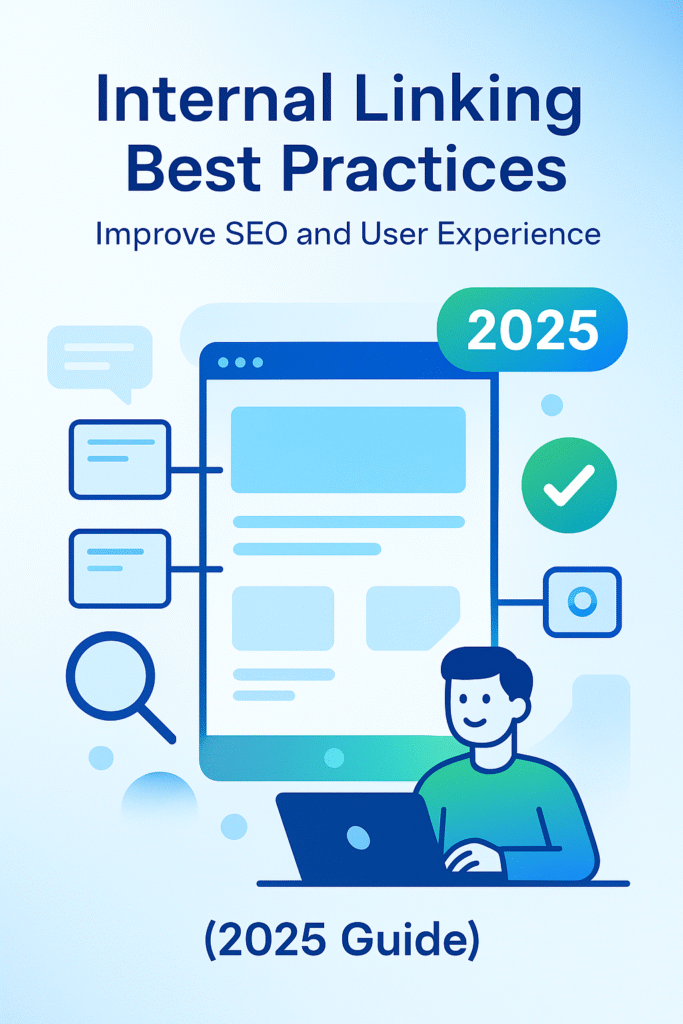Internal Linking Best Practices Improve SEO and User Experience 2025 Guide
When it comes to building a powerful website that ranks well on Google and keeps visitors engaged, internal linking is your secret weapon. Internal links may seem simple, but they play a powerful role in boosting both SEO and user experience.
Let’s break down everything you need to know — in simple, actionable language — so you can use internal linking to your advantage in 2025.
🔗 What is Internal Linking?
An internal link is a hyperlink that connects one page of your website to another page on the same domain.
For example:
On a blog post about “Social Media Strategy,” linking to another post about “Instagram Reels Tips” is an internal link.
These links help both search engines and users discover more content on your site.
🚀 Why Internal Linking Matters
🧠 For SEO:
- Helps Google crawl your website better
- Distributes link equity (PageRank) across your site
- Boosts keyword relevance for target pages
- Increases indexation of deeper pages
👨💻 For Users:
- Keeps visitors engaged longer (lower bounce rate)
- Helps them find relevant content quickly
- Improves overall site navigation
💡 Think of your website like a city, and internal links like roads — without them, everything is isolated and harder to explore.
✅ Internal Linking Best Practices (2025 Edition)
Here’s how to do it right:
1. Use Descriptive Anchor Text
Instead of vague text like “click here,” use anchor text that includes relevant keywords.
Example:
✔️ Learn more about our email marketing strategies
❌ Click here to read
This helps Google understand the content of the linked page.
2. Link to Relevant Pages Only
Don’t just link for the sake of it. Make sure the linked page adds value to the current topic.
Ask yourself: Will the reader benefit from this page?
3. Use a Logical Linking Structure
Organize internal links based on your site hierarchy:
- Homepage → Category page → Blog post/product page
- Blog post → Related blog post
This tells Google which pages are most important.
4. Link from High Authority Pages
Pages that get high traffic or backlinks can pass that authority to other pages when you internally link from them.
Pro Tip: Update old blog posts and add links to new, important pages.
5. Don’t Overdo It
When it comes to internal links, less is often more — stick to 2–6 links per 1,000 words to keep things clear and effective.
6. Include Contextual Links Early in Content
Links placed in the first few paragraphs tend to perform better for both users and crawlers.
7. Use Breadcrumbs and Navigation Menus
Internal links aren’t just in the content. Menus, breadcrumbs, and footer links also help improve navigation and SEO.
Breadcrumbs = Navigation paths like Home > Services > SEO Optimization
8. Fix Broken Internal Links
A broken internal link creates a bad user experience and can hurt your SEO.
Use tools like:
- Screaming Frog
- Ahrefs
- Semrush Site Audit
To find and fix 404 errors.
9. Create Content Clusters
Group your content into themes.
Example:
- Pillar Content: “Complete Guide to Digital Marketing”
- Cluster Pages: Blog posts about SEO, Email Marketing, Google Ads, etc.
Interlink these pages to form a topic cluster. This signals to Google that you’re an authority on that subject.
10. Use Tools to Track Internal Link Health
Some handy tools:
- ✅ Yoast SEO (for WordPress)
- ✅ Link Whisper
- ✅ Ahrefs Site Audit
- ✅ Google Search Console > Links Report
These help you analyze link distribution and optimize it further.
🧪 Internal Linking Mistakes to Avoid
❌ Linking too often to the same page with exact match anchor text
❌ Linking to irrelevant pages
❌ Ignoring orphan pages (pages with no internal links)
❌ Relying only on auto-generated internal links
🔍 Real Results from Smart Internal Linking
Here’s what you can expect when you apply these practices:
- ✅ Higher rankings for key pages
- ✅ Lower bounce rate
- ✅ Better site structure for Google crawling
- ✅ Increased user engagement & conversions
💬 “After optimizing internal links, one of our blog pages jumped from page 3 to page 1 in just 2 weeks.” — Kanity Solutions Team
🧭 Final Thoughts
Internal linking is not just a technical SEO trick — it’s about guiding your visitors, boosting your site structure, and making your content work together as a team.
Start small: update your top-performing blogs and add smart, helpful internal links. Then scale it across your site.
Remember: Every internal link is a chance to keep a user on your site longer and improve your rankings at the same time.
🔧 Need help auditing and optimizing your website’s internal links?
Let the team at Kanity Solutions handle it for you.
👉 Visit www.kanity.in or call +91 9454784602 for a free consultation.

